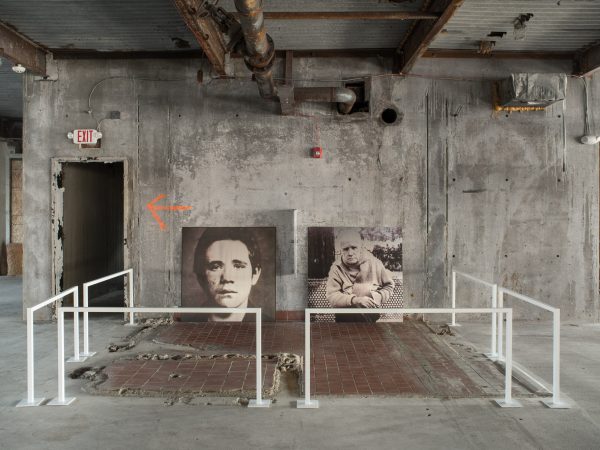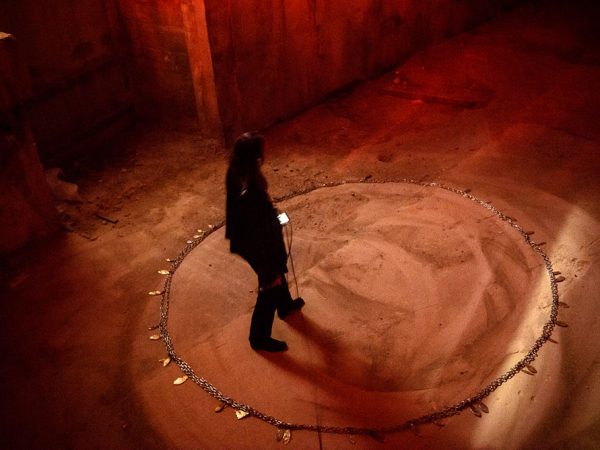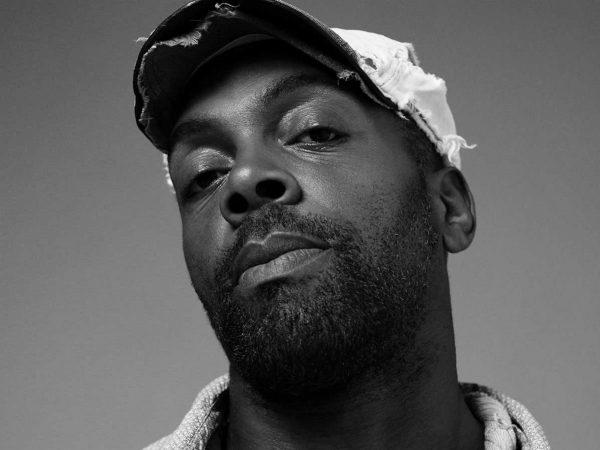
The duo behind Girlpool sit down with Document to discuss their new album and their evolving relationship to each other and their music.
Girlpool’s new album, What Chaos Is Imaginary, is a compilation of songs written independently, rearranged and produced together by Cleo Tucker and Harmony Tividad. The writing process for this record was a departure from how the duo collaborated on previous music. As Tucker explains, “Before, the core of us shared space in every song, and now one person’s core is the structure of the song, and the other person gets to visit and enhance it.” This new mode of making was born out of Tucker and Tividad living separately between New York, Los Angeles, and Philadelphia. The result is an album that gives space to the complex relationship between the distinctive writing styles of the two musicians, and synthesizes the unique realities of being out in the world on their own. Document spoke with Tucker and Tividad in Los Angeles about exploring new forms of instrumentation, the responsibility of visual elements, and their evolving relationship to each other and their music.
Above The Fold

Sam Contis Studies Male Seclusion

Slava Mogutin: “I Transgress, Therefore I Am”

The Present Past: Backstage New York Fashion Week Men’s Spring/Summer 2018

Pierre Bergé Has Died At 86

Falls the Shadow: Maria Grazia Chiuri Designs for Works & Process

An Olfactory Memory Inspires Jason Wu’s First Fragrance

Brave New Wonders: A Preview of the Inaugural Edition of “Close”

Georgia Hilmer’s Fashion Month, Part One

Modelogue: Georgia Hilmer’s Fashion Month, Part Two

Surf League by Thom Browne

Nick Hornby: Grand Narratives and Little Anecdotes

The New Helmut

Designer Turned Artist Jean-Charles de Castelbajac is the Pope of Pop

Splendid Reverie: Backstage Paris Haute Couture Fall/Winter 2017

Tom Burr Cultivates Space at Marcel Breuer’s Pirelli Tire Building

Ludovic de Saint Sernin Debuts Eponymous Collection in Paris

Peaceful Sedition: Backstage Paris Fashion Week Men’s Spring/Summer 2018

Ephemeral Relief: Backstage Milan Fashion Week Men’s Spring/Summer 2018

Olivier Saillard Challenges the Concept of a Museum

“Not Yours”: A New Film by Document and Diane Russo

Introducing: Kozaburo, 2017 LVMH Prize Finalist

Introducing: Marine Serre, 2017 LVMH Prize Finalist

Conscious Skin

Escapism Revived: Backstage London Fashion Week Men’s Spring/Summer 2018

Introducing: Cecilie Bahnsen, 2017 LVMH Prize Finalist

Introducing: Ambush, 2017 LVMH Prize Finalist

New Artifacts

Introducing: Nabil Nayal, 2017 LVMH Prize Finalist

Bringing the House Down

Introducing: Molly Goddard, 2017 LVMH Prize Finalist

Introducing: Atlein, 2017 LVMH Prize Finalist

Introducing: Jahnkoy, 2017 LVMH Prize Finalist

LVMH’s Final Eight

Escaping Reality: A Tour Through the 57th Venice Biennale with Patrik Ervell

Adorned and Subverted: Backstage MB Fashion Week Tbilisi Autumn/Winter 2017

The Geometry of Sound

Klaus Biesenbach Uncovers Papo Colo’s Artistic Legacy in Puerto Rico’s Rainforest

Westward Bound: Backstage Dior Resort 2018

Artist Francesco Vezzoli Uncovers the Radical Images of Lisetta Carmi with MoMA’s Roxana Marcoci

A Weekend in Berlin

Centered Rhyme by Elaine Lustig Cohen and Hermès

How to Proceed: “fashion after Fashion”

Robin Broadbent’s Inanimate Portraits

“Speak Easy”

Revelations of Truth

Re-Realizing the American Dream

Tomihiro Kono’s Hair Sculpting Process

The Art of Craft in the 21st Century

Strength and Rebellion: Backstage Seoul Fashion Week Autumn/Winter 2017

Decorative Growth

The Faces of London

Document Turns Five

Synthesized Chaos: “Scholomance” by Nico Vascellari

A Whole New World for Janette Beckman

New Ceremony: Backstage Paris Fashion Week Autumn/Winter 2017

New Perspectives on an American Classic

Realized Attraction: Backstage Milan Fashion Week Autumn/Winter 2017

Dematerialization: “Escape Attempts” at Shulamit Nazarian

“XOXO” by Jesse Mockrin

Brilliant Light: Backstage London Fashion Week Autumn/Winter 2017

The Form Challenged: Backstage New York Fashion Week Autumn/Winter 2017

Art for Tomorrow: Istanbul’74 Crafts Postcards for Project Lift

Inspiration & Progress

Paskal’s Theory of Design

On the Road

In Taiwan, American Designer Daniel DuGoff Finds Revelation

The Kit To Fixing Fashion

The Game Has Changed: Backstage New York Fashion Week Men’s Autumn/Winter 2017

Class is in Session: Andres Serrano at The School

Forma Originale: Burberry Previews February 2017

“Theoria”

Wearing Wanderlust: Waris Ahluwalia x The Kooples

Approaching Splendor: Backstage Paris Haute Couture Spring/Summer 2017

In Florence, History Returns Onstage

An Island Aesthetic: Loewe Travels to Ibiza

Wilfried Lantoine Takes His Collection to the Dancefloor

A Return To Form: Backstage New York Fashion Week Spring/Summer 2018

20 Years of Jeremy Scott

Offline in Cuba

Distortion of the Everyday at Faustine Steinmetz

Archetypes Redefined: Backstage London Fashion Week Spring/Summer 2018

Spring/Summer 2018 Through the Lens of Designer Erdem Moralıoğlu

A Week of Icons: Backstage Milan Fashion Week Spring/Summer 2018

Toasting the New Edition of Document

Embodying Rick Owens

Prada Channels the Wonder Women Illustrators of the 1940s

Andre Walker’s Collection 30 Years in the Making

Fallen From Grace, An Exclusive Look at Item Idem’s “NUII”

Breaking the System: Backstage Paris Fashion Week Men’s Autumn/Winter 2017

A Modern Manufactory at Mykita Studio

A Wanted Gleam: Backstage Milan Fashion Week Men’s Autumn/Winter 2017

Fashion’s Next, Cottweiler and Gabriela Hearst Take International Woolmark Prize

Beauty in Disorder: Backstage London Fashion Week Men’s Autumn/Winter 2017

“Dior by Mats Gustafson”

Prada’s Power

George Michael’s Epochal Supermodel Lip Sync

The Search for the Spirit of Miss General Idea

A Trace of the Real

Wear and Sniff

Underwater, Doug Aitken Returns to the Real
Document—How did it feel to let somebody else come into a world of a lived experience that you had written about?
Cleo Tucker—We do have emotional attachment to the songs that aren’t ours because we love each other. But when you invite someone in to paint the wall in a space that you built, it’s trying at times. There would be moments where one of us would say, ‘I want you to do this and I want you here,’ and the other would say ‘I don’t fuck with it.’ It was a different dynamic.
Harmony Tividad—When we were writing these songs, we were sending them to each other, and were in deep communication all the time, so there is just so much awareness surrounding the worlds in which these songs were created.
Harmony—It’s creating this new context for the songs to exist in. ‘Pretty,’ one of the songs on the new record, is so old. I wrote it probably when I first met Cleo, and we recorded it. It’s weird that we finally get to fully realize that together. That person who wrote that is still in me and part of me, but has completely changed, and Cleo knows who that person was and saw that person exist. It feels like there is this weird safety to be able to share that, because there is a really deep understanding of where it came from.
Cleo—It always feels like the songs are way too old for me. When I want to put out music, or when I finally have the sound right, it always feels far away. But it’s strange that this feeling co-exists with this new dynamic that Harmony and I have with all of these old songs. The shift makes sense because for a while there was this enmeshment, and it felt really good and we needed it, of course, but it was difficult for us to separate from each other. We met in a really sacred place. The songs were the way that our relationship was—merged.
Harmony—We met when we were really young and malleable, and we were like, ‘We’re doing this!’ It was immersive, and we were obviously not fully developed. We would’ve been entering college when we started touring as Girlpool.
Cleo—I was 18.
Harmony—And I was 19.
Cleo—We were really figuring things out.
Harmony—It was like we were in a private school, but we were the teachers, to ourselves and to each other.
“My goal is that I really want to tell a story. I’m just looking for things to carry my words forward.”—Harmony Tividad
Document—What was it like to incorporate new string and synth instrumentation?
Harmony—We got the stems for the strings and they were just so specific. It was really interesting trying to figure out how to fill them out, but also not overstep them.
Cleo— I feel like I always have so much to say about this record, because there is so much to explain. It is a transitional-sounding album, because I am so over rock music. I love it and it has formed everything in me, I grew up on it. I’m just not interested in making it anymore right now. When we were recording it, a lot of the songs I wrote were rock songs. I wanted to make them warmer, and more interesting, and weird, and jazzier, but I didn’t really get to do that, which is fine because they were written that way, and I wanted to put them out. But then there are things on this album, like the synth and like the strings, that are just almost ethereal, that step outside of this vanilla shit. I’m not saying that there can’t be so much in a vanilla song, like some honky-tonk rock or indie rock song—I’m a sucker for that. But there is space in this album where it does walk into those kinds of rooms differently. Some of the songs could be B-sides on our last record, Powerplant, and then others step into a new place.
Harmony—My songs that are more rock are more Cranberries-oriented. I still feel connected to things that are of that plane, but now I’m listening to the Cocteau Twins more, or The Sundays. To me, this point of reference is still relevant to where my heart is. I feel like I’ve been sitting in the same spot for a long time with what I write. I would still record the songs that I’m putting out, like “What Chaos is Imaginary,” the same [way]. That song is perfect to me.
Cleo—That song is perfect to me too. I think that we’re in separate places in our own journey, because I’m changing everything. My music is changing completely. And [turning to Tividad] your core has been in the same place for a long time. We generally have a completely different relationship to the album.
Harmony—And music.
Cleo—Yeah, which I think is so cool because we didn’t know that before. We kind of just didn’t talk about it.
Harmony—We just blended together, and we were down for it.
Cleo—We didn’t think about it. Now it’s like, ‘Oh wait, what do you like?’ And that honestly has a lot to do with my transition, because I was trying to meet Harmony somewhere.
Document—How do you decide how a song will sound on the album? What was it like to record the title track versus a song with a more DIY feel, like ‘Hoax and the Shrine?’
Harmony—For ‘Hoax’ we talked about having drums. There was a moment where I was playing it, but we thought it was degrading the pureness of it.
Cleo—With ‘Chaos,’ we really developed a vision together, because there was so much potential. It’s my favorite song that Harmony has ever written. I would see her play that song and would be like, ‘Holy fuck, this song is poetry.’ She would play it on her acoustic guitar, beautifully, and it’s great like that, but it’s so cool when you see a song that can almost exist in any way—that’s how good it is.
Harmony—I love that you love it.
Cleo—‘Good’ isn’t even the right word. It just transcends.
“We’ve never sat down and planned themes. Girlpool is just a picture of where we are, together, always.”—Cleo Tucker
Harmony—I remember I did a really crazy electronic demo of it in 2016, and it was this weird pop math-y version. I thought it was cool like that, but I knew it could really be beautiful. I’ve tried it a lot of different ways.
Cleo—When I heard that version, it didn’t come through to me. When I heard you play it on the guitar, that’s when it came through and that’s when I said this has to be a movie, this has to be a Lana Del Rey song. And that’s what it became. It needed drums like the ones in ‘Ride’—that heartbeat. Harmony can just write, write, write, and I love getting it dressed.
Harmony—Cleo will write a part and just meditate that part, and loops it and eats it. His orientation is more towards sound, tone, and creating a world. I was watching a Vashti Bunyan video last night and thinking how good she is at creating a whole world with one guitar. ‘Train Song’ is insane. She starts playing and you’re like, ‘Where am I?’ You’re teleported. My goal is that I really want to tell a story. I’m just looking for things to carry my words forward. I love creating worlds, but it’s more about the peaks and valleys and drops for me. Going from one texture to another is exciting, because I like feeling that contrast, but the peak is more in the emotional dialogue.
Document—Is there an overall concept of the album?
Cleo—There isn’t. I think that you just have to let it happen and then the finished thing is a bunch of processes that are all connected to each other. We’ve never sat down and planned themes. Girlpool is just a picture of where we are, together, always.
Document—Does the location of where you write and record affect the final record? If so, where do you feel most at home?
Harmony—Every song that’s about image culture, like ‘Lucky Joke,’ I wrote in LA. I wrote that song after going to a really ritzy party, and that could only come from [LA], or how I have historically felt about being in LA. Location affects it because you’re experiencing certain things there. ‘Chaos’ happened in Philly because I was living a really unhealthy life.
Document—Cleo, your voice is in a lower register than on previous albums. Has this provided any musical illuminations or challenges for you both while composing? What has it been like, over the course of writing together, to divert from the initial same octave unison that you often used in earlier music?
Cleo—It was really chaotic, the first year. We did a tour last February, where my voice was completely out of control. I would just stop singing because it was getting so frustrating. It just sounded bad and was so taxing all the time. I took a couple of voice lessons, but the only thing I could really do was just wait for it to settle, and it was still not settling by the time we were recording. There was a lot of trial and error and vocal takes and figuring it out. I still felt like I was pushing really hard. Only recently has it felt like I have begun to land in a more comfortable register. It’s really just more about something that feels so intimate all of the sudden becoming completely foreign. I don’t think ‘set me back’ is the appropriate language to describe it, because it’s setting me forward. But all that time that it’s taken, where I didn’t feel drawn to sitting down and writing and singing, felt just so sad, and scary—that I couldn’t control it. I think meditation and waiting has benefited me quite a bit—I’m excited about it now. It’s definitely taken a lot of adjustment for us, though, it’s like a new person to sing with.
Document—How do you approach choosing the visual components, in music videos, to aid the sonic choices that you make?
Harmony—I feel like videos, and all visual work, are another track on the song. It’s the responsibility of the visual work to be another layer to the song.
Cleo—It’s just one performance of it. It’s one way to show it off and perform it, but I feel like I could make a bunch of different kinds of things for it. It’s interesting—we actually feel really different about that.
Harmony—Well, I agree that I could do it a bunch of different ways. But there is a creative responsibility to the song, to make visual work that’s reflective of it, in a way that’s apt, and not something that dislocates the music. I don’t want to make a video that is vacant, and I also don’t want to just make something for the sake of making it. I feel like today we’re in such a visual world, filled with sensational image-oriented shit, and people are really making videos just to just get promo.
Cleo—Yeah, It’s not an accessory. It’s an opportunity to explore the song.
Harmony—To further the work, and not distract from it. Or to create a visual idea of what world you’re envisioning it in. For ‘Where You Sink,’ I made a video because I thought it was a bizarre way to view how we look for connection in people, and how connection is so often this disjointed, awkward, impossible thing. Words are just air!
Document—You both were photographed for the album art. Was this a conscious decision? Do you think it lends anything specific to the record?
Harmony—Cleo’s literally been on this tip forever. I remember before we even started recording you were like, ‘let’s be the cover.’
Cleo—I always wanted it to be a photo of us, because it’s us. I love albums when you can look at the person who made it. It’s no coincidence that this album really carries our identities in two hands. It’s pretty beautiful that the image conveys there are two people at work and we’re supporting one another, up in the sky.


















